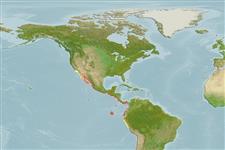Common names from other countries
>
Eupercaria/misc (Various families in series Eupercaria) >
Lutjanidae (Snappers) > Lutjaninae
Etymology: Lutjanus: Malay, ikan lutjan, name of a fish.
More on author: Peters.
Environment: milieu / climate zone / depth range / distribution range
Ecologia
marinhas; estuarina associadas(os) a recifes; intervalo de profundidade 3 - 60 m (Ref. 9313). Subtropical; 36°N - 13°S, 120°W - 77°W (Ref. 55)
Eastern Pacific: southern California to Peru, rare north of Baja California, Mexico; also at the Cocos and Galapagos islands.
Length at first maturity / Tamanho / Peso / Idade
Maturity: Lm 19.5, range 19 - 20 cm
Max length : 71.0 cm TL macho/indeterminado; (Ref. 40637); peso máx. Publicado: 13.0 kg (Ref. 40637)
Descrição breve
Chaves de identificação | Morfologia | Morfometria
Espinhos dorsais (total) : 10; Raios dorsais moles (total) : 14; Espinhos anais: 3; Raios anais moles: 8. Forehead slopes steeply; snout somewhat pointed. Preopercular notch and knob weak. Scale rows on back parallel with lateral line. Rosy red anteriorly, becoming bright orange to yellow over most of the body; the fins are mainly yellow or orange; the inside of the mouth is white; a bluish horizontal streak runs below the eye.
Found in inshore reef areas over hard bottoms until at least 60 m depth (Ref. 9313). Tolerant to freshwaters (Ref. 36880). Form aggregations during daylight and shelter as solitary fish in caverns. Feed on fishes, shrimps, crabs and mollusks. Marketed fresh or frozen (Ref. 9313).
Allen, G.R., 1985. FAO Species Catalogue. Vol. 6. Snappers of the world. An annotated and illustrated catalogue of lutjanid species known to date. FAO Fish. Synop. 125(6):208 p. Rome: FAO. (Ref. 55)
Categoria na Lista Vermelha da IUCN (Ref. 130435)
CITES (Ref. 128078)
Not Evaluated
Ameaça para o homem
Harmless
Utilização humana
Pescarias: espécies comerciais; Aquacultura: experimental
Ferramentas
Relatórios especiais
Descarregue XML
Fontes da internet
Estimates based on models
Preferred temperature (Ref.
115969): 20.5 - 28.6, mean 25.8 (based on 84 cells).
Phylogenetic diversity index (Ref.
82804): PD
50 = 0.5000 [Uniqueness, from 0.5 = low to 2.0 = high].
Bayesian length-weight: a=0.01479 (0.01296 - 0.01687), b=2.97 (2.94 - 3.00), in cm Total Length, based on LWR estimates for this species (Ref.
93245).
Nível Trófico (Ref.
69278): 4.0 ±0.63 se; based on food items.
Resiliência (Ref.
120179): Baixo, tempo mínimo de duplicação da população 4,5 - 14 anos (K=0.15;).
Fishing Vulnerability (Ref.
59153): High vulnerability (56 of 100).
Climate Vulnerability (Ref.
125649): Very high vulnerability (80 of 100).
